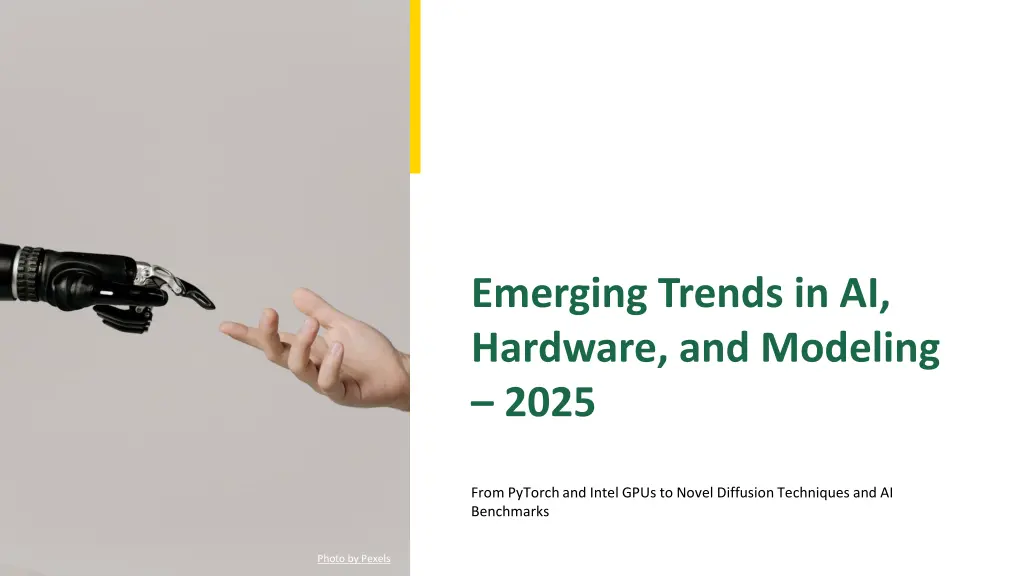
2025 Trends in AI, Hardware, and Modeling: PyTorch, Intel GPUs, and More
Discover the latest trends in AI, hardware, and modeling for 2025, including advancements in PyTorch, Intel GPUs, diffusion techniques, and AI benchmarks. Explore topics like memory in time-dependent PDEs, inverse bench framework, and new models such as Xiaomi MiMo-7B. Stay informed about cutting-edge technologies shaping the future of artificial intelligence.
Download Presentation

Please find below an Image/Link to download the presentation.
The content on the website is provided AS IS for your information and personal use only. It may not be sold, licensed, or shared on other websites without obtaining consent from the author. If you encounter any issues during the download, it is possible that the publisher has removed the file from their server.
You are allowed to download the files provided on this website for personal or commercial use, subject to the condition that they are used lawfully. All files are the property of their respective owners.
The content on the website is provided AS IS for your information and personal use only. It may not be sold, licensed, or shared on other websites without obtaining consent from the author.
E N D
Presentation Transcript
Emerging Trends in AI, Hardware, and Modeling 2025 From PyTorch and Intel GPUs to Novel Diffusion Techniques and AI Benchmarks Photo by Pexels
01 PyTorch 2.7 + Intel GPUs Table of Contents 02 NATTEN by SHI-Labs 03 Memory in Time-Dependent PDEs 04 InverseBench Framework 05 Level1Techs Dual RTX 5090 Build 06 L4DC 2025 Registration Open 07 Alibaba Qwen3 Models 08 Interpreting Transformer Attention 09 Abliteration: Uncensoring LLMs 10 Xiaomi MiMo-7B Model 11 Entropic Time Schedulers 12 Transformers vs. State Space Models
1 PyTorch 2.7 + Intel GPUs Speed and platform enhancements with Intel hardware PyTorch 2.7 improves support for Intel GPUs on Windows and Linux. Integration of SDPA boosts inference speeds up to 3x. Notable hardware: Intel Arc B580 Graphics, Intel Core Ultra 7. Photo by Pexels
2 NATTEN by SHI-Labs Neighborhood Attention Extension in PyTorch NATTEN implements localized attention mechanisms. Supports both local and dilated attention types. Enhances performance in vision-relatedmodels. Photo by Pexels
3 Memory in Time-Dependent PDEs Advantages of Memory Neural Operators (MemNO) MemNO blends state space models and Fourier Neural Operators. Significant improvements over Markovian models. Performs well with low-resolution or noisy data. Photo by Pexels
4 InverseBench Framework Benchmarking Diffusion for Inverse Problems InverseBench evaluates diffusion models across 14 tasks. Focus areas: tomography, medical imaging, fluid dynamics. Highlights strengths/weaknesses of existing approaches. Photo by Pexels
5 Level1Techs Dual RTX 5090 Build Extreme PC Setup for AI and Content Creation Showcases custom Silverstone build with dual RTX 5090 GPUs. Optimized for high-demandworkloads. Ideal for creators and AI researchers alike. Photo by Pexels
6 L4DC 2025 Registration Open Learning for Dynamics and Control Conference Scheduled for June 5-6, 2025; tutorials on June 4. Early bird deadline: May 2, 2025. NSF-funded studenttravel grants available. Photo by Pexels
7 Alibaba Qwen3 Models New State-of-the-Art Hybrid AI Models Open-weight models with MoE and dense types. Range from 0.6B to 235B parameters. Claimed parity or better performance than Google/OpenAI models. Photo by Pexels
8 Interpreting Transformer Attention Anthropic s Insights on Transformer Mechanisms Analyzes attention superposition and cross-layer reps. QK diagonalization proposed to improve interpretability. Improves our understanding of how models reason. Photo by Pexels
9 Abliteration: Uncensoring LLMs Technique to Remove Refusal Mechanisms Targets specific refusal-behaviorvectors in LLMs. Does not requireretraining. Raises ethical and safety implications. Photo by Pexels
10 Xiaomi MiMo-7B Model Compact Reasoning Model with Big Potential 7B parameters trained from scratch. Outperforms larger models in math/code tasks. Uses dense RL strategies. Photo by Pexels
11 Entropic Time Schedulers Entropy-Based Sampling for Diffusion Models Uses entropyrather than uniform time steps. Ensures each step contributes meaningfully. May enhance diffusion outputquality. Photo by Pexels
12 Transformers vs. State Space Models Architecture Comparison by Albert Gu SSMs excel in sequence modeling. Transformers outperform in algorithmic tasks. Suggests hybridarchitectures could be optimal. Photo by Pexels
